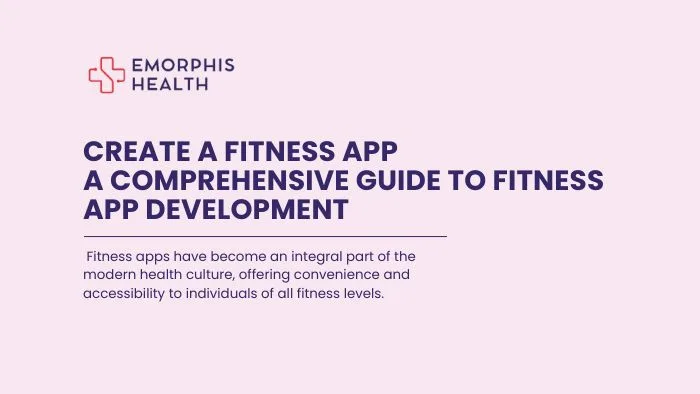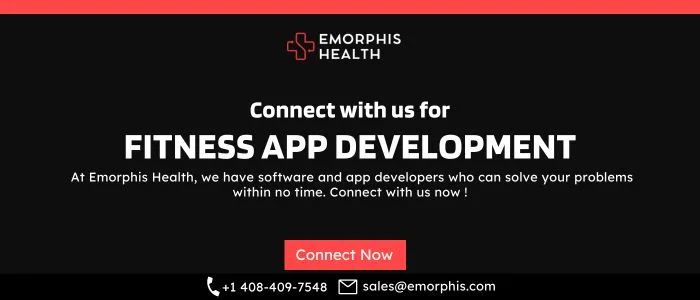Introduction
See Contents
- 1 Introduction
- 2 Market Research and Analysis Steps – Unveiling the Path to Successful Fitness App Development
- 3 Defining Core Features and Functionalities – Crafting a Comprehensive Fitness App Experience
- 4 Choosing the Right Technology Stack – A Crucial Step in Fitness App Development
- 5 User Interface (UI) and User Experience (UX) Design – Crafting an Exceptional Fitness App
- 6 Fitness App Development Process
- 7 Cost of Fitness App Development
- 8 Data Security and Privacy Measures – Safeguarding User Information in Fitness App Development
- 9 Testing and Quality Assurance – Ensuring a Seamless Fitness App Experience
- 10 Launch Strategy: Unveiling Your Fitness App to the World
- 11 Monetization Models – Maximizing Revenue in Fitness App Development
- 12 Future Trends in Fitness App Development – Embracing Innovation for a Healthier Tomorrow
- 13 Conclusion
Staying healthy is important. Hence in the current time, we can notice a surge in fitness application usage. With the rise of smartphones and mobile applications, creating a fitness app has become an innovative way to help individuals achieve their health and wellness goals.
Let us explore creating a fitness app that involves navigating essential steps, making strategic technology choices, and staying attuned to industry trends for a successful and effective development journey. But, firstly let us look at the significance of fitness apps in modern health culture and outline the goals and objectives of developing or creating a fitness app.
Significance of Fitness Apps in Modern Health Culture
The increasing awareness of the importance of a healthy lifestyle has led to a surge in the popularity of fitness apps. These apps play a crucial role in promoting physical activity, providing personalized workout plans, and tracking progress.
Moreover, they act as virtual companions, motivating users to stay consistent with their fitness routines. Fitness apps have become an integral part of the modern health culture, offering convenience and accessibility to individuals of all fitness levels.
According to Statista report, the global Fitness Apps market is poised for substantial growth, with a projected revenue of US$6.86 billion by 2024. This anticipated expansion implies an impressive annual growth rate (CAGR 2024-2028) of 9.99%, culminating in a projected market volume of US$10.04 billion by 2028. Furthermore, the average revenue per user (ARPU) is expected to reach US$17.84.
Notably, the United States is predicted to be a major contributor to this growth, generating the highest revenue globally at US$2,061.00 million in 2024. In fact, the worldwide surge in fitness app usage is evident, with countries such as the United States leading the way in both app downloads and user engagement. This data underscores the significant impact and widespread adoption of fitness apps globally.
Goals and Objectives of Creating a Fitness App
When embarking on fitness app development or creating a fitness app, it is essential to define clear goals and objectives. The primary goal is to provide users with a seamless and user-friendly platform that enhances their overall fitness experience. Moreover, incorporating features such as personalized workout plans, nutrition tracking, and progress analytics adds value to the app. In fact, a well-designed fitness app aims to cater to the diverse needs of users, whether they are beginners looking to start their fitness journey or experienced enthusiasts seeking advanced workout routines.
Market Research and Analysis Steps – Unveiling the Path to Successful Fitness App Development
Before embarking on the journey of creating a fitness app, thorough market research and analysis are paramount. This process involves identifying the target audience, studying competitor fitness apps, and understanding market trends and opportunities. In this article, we delve into the essential aspects of market research to guide developers in creating a fitness app that stands out in a competitive landscape.
Step 1. Identifying Target Audience and Market Niche
Understanding the target audience is the cornerstone of a successful for creating a fitness app. Developers need to identify the specific demographics, interests, and fitness goals of their potential users. Moreover, pinpointing a market niche is crucial to tailor the app’s features to meet the unique needs of a particular segment. By doing so, developers can create a more focused and appealing fitness app that resonates with its intended users.
Step 2. Studying Competitor Fitness Apps
In the crowded fitness app market, studying competitors is a strategic move. Analyzing competitor fitness apps provides insights into their strengths, weaknesses, and unique selling points. Moreover, developers can learn from competitor successes and failures to refine their own app’s features and marketing strategies. Additionally, when creating a fitness app, it is necessary to understand user reviews of competitor apps to aid in identifying areas for improvement and innovation.
Step 3. Market Trends and Opportunities in Creating a Fitness App
To stay ahead in the competitive landscape, developers must be aware of current market trends and emerging opportunities in the fitness app domain. By keeping a pulse on industry trends, such as the integration of virtual reality in workouts or the rise of AI-driven personalization, developers can align their apps with the latest innovations. Moreover, identifying gaps in the market allows developers to capitalize on untapped opportunities, creating a fitness app that meets evolving user needs.
Defining Core Features and Functionalities – Crafting a Comprehensive Fitness App Experience
In the process of creating a fitness app, defining core features and functionalities is pivotal to delivering a comprehensive and user-friendly experience. This article explores the key elements that should be incorporated into a fitness app, including user profile and registration, activity tracking, customized workout plans, nutrition tracking, and social integration for community building.
Feature 1. User Profile and Registration
A seamless user registration process and a well-crafted user profile are the foundation of any fitness app. During registration, users should be able to input essential information such as age, weight, fitness goals, and medical history. Additionally, providing options for social media login simplifies the onboarding process. The user profile serves as a central hub for personalization, enabling the app to tailor recommendations and plans based on individual preferences and objectives.
Feature 2. Activity Tracking and Monitoring
Activity tracking lies at the heart of a fitness app, empowering users to monitor their physical exertion and progress. Integrating features such as step counting, distance tracking, and calorie expenditure provides users with real-time insights into their daily activities. Moreover, incorporating GPS functionality allows users to track outdoor activities, fostering a more comprehensive overview of their fitness journey.
Feature 3. Customized Workout Plans
One of the core attractions of a fitness app is the ability to offer personalized workout plans. Developers should design the app to assess user preferences, fitness levels, and goals to generate tailored workout routines. Including a variety of exercises, difficulty levels, and duration options ensures that users can find plans that suit their individual needs. Regular updates to workout plans keep the app dynamic, encouraging user engagement over the long term.
Feature 4. Nutrition Tracking and Diet Recommendations
Complementing physical activity, nutrition tracking plays a vital role in a holistic fitness app. Users should be able to log their daily food intake, track macronutrients, and set dietary preferences. The app can then provide personalized diet recommendations based on individual fitness goals, ensuring users receive comprehensive guidance for a healthy lifestyle. Integration with a vast database of food items simplifies the tracking process, making it more user-friendly.
Feature 5. Social Integration for Community Building
To enhance user engagement and motivation, social integration is a key feature in the creation of a fitness app. Users should have the option to connect with friends, share achievements, and participate in challenges. Incorporating a news feed, chat functionality, and community forums fosters a sense of belonging and accountability. Moreover, allowing users to follow fitness influencers, join groups, and celebrate milestones together creates a vibrant and supportive fitness community within the app.
Choosing the Right Technology Stack – A Crucial Step in Fitness App Development
As the demand for fitness apps continues to rise, creating a fitness app with cutting-edge technology is essential for success. In this article, we delve into the crucial aspects of choosing the right technology stack for fitness app development. From backend development technologies to frontend development frameworks, and database selection to API integration, each element plays a significant role in crafting a seamless and efficient fitness app.
a. Backend Development Technologies
The backend of a fitness app is the engine that powers its functionality. Choosing the right backend development technologies is crucial for ensuring speed, reliability, and scalability. In fact, technologies like Node.js, Python with Django, or Ruby on Rails are popular choices due to their versatility and robust performance. Moreover, selecting backend development services and technology that supports real-time data processing is vital for features like instant workout updates and live tracking for creating a fitness app.
b. Frontend Development Frameworks
The frontend is the user’s gateway to the fitness app, making the selection of frontend development frameworks a critical decision. Developers can opt for frameworks like React, Angular, or Vue.js for creating responsive and interactive user interfaces. Additionally, the use of progressive web app (PWA) technologies enhances the user experience by allowing offline access and faster loading times. As a matter of fact, a well-designed and visually appealing frontend contributes significantly to user engagement.
c. Database Selection
Efficient data management is fundamental in fitness app development. Choosing the right database is essential for storing and retrieving user information, workout history, and other relevant data. SQL databases like PostgreSQL or MySQL are reliable choices for structured data, while NoSQL databases like MongoDB offer flexibility for handling unstructured data. The decision should align with the app’s specific requirements and scalability needs.
d. API Integration for Enhanced Functionality
API integration opens the door to enhanced functionality and connectivity in a fitness app. Integrating with fitness wearables, nutrition databases, or location-based services can provide users with a more comprehensive experience. Moreover, integrating social media APIs allows users to share achievements and connect with their fitness community directly from the app. This not only enhances user engagement but also contributes to the app’s overall value proposition.
User Interface (UI) and User Experience (UX) Design – Crafting an Exceptional Fitness App
In the realm of fitness app development, User Interface (UI) and User Experience (UX) design play a pivotal role in shaping the success and user satisfaction of the app. This article explores the fundamental design principles, the creation of an intuitive and engaging user interface, and the incorporation of gamification to enhance user motivation during the process of creating a fitness app.
1. Design Principles for Creating a Fitness App
Designing a fitness app that resonates with users requires adherence to fundamental design principles. Clarity, simplicity, and consistency form the cornerstone of an effective UI/UX design. Moreover, incorporating elements such as visual hierarchy, intuitive navigation, and responsive design ensures a seamless and enjoyable user experience. As a matter of fact, a well-designed fitness app should prioritize user-centricity, putting the needs and preferences of the users at the forefront of the design process.
2. Creating an Intuitive and Engaging User Interface
The user interface serves as the bridge between users and the functionalities of the fitness app. Creating an intuitive and engaging UI is paramount for attracting and retaining users. Incorporating a visually appealing color scheme, easily recognizable icons, and clear typography enhances the overall aesthetics of the app. Moreover, organizing information in a logical and easily navigable manner contributes to a positive user experience. In fact, a thoughtfully designed UI streamlines user interactions, making it easier for individuals to access the features they need.
3. Incorporating Gamification for User Motivation
Gamification is a powerful tool for enhancing user motivation and engagement in a fitness app. When creating a fitness app, by integrating game-like elements such as achievements, badges, and challenges, developers can make the fitness journey more enjoyable and rewarding. Moreover, incorporating progress tracking and personalized goals adds a competitive and fun aspect to users’ workouts. Furthermore, social features like leaderboards and friendly competitions foster a sense of community and accountability, also when creating a fitness app, you need to consider a point that is very important for motivating users to stay committed to their fitness goals. hence, incorporating gamification is must have feature when creating a fitness app.
Fitness App Development Process
Step 1. Idea and Conceptualization
- Define your target audience – Identify the age group, fitness level, and interests of your potential users.
- Fitness goals – Clearly articulate the fitness goals your app will help users achieve, whether it’s weight loss, muscle gain, general fitness, or specific sports training.
- Unique features – Brainstorm and define features that will make your app stand out, such as AI-driven personalized workout plans, social challenges, or advanced analytics.
Step 2. Market Analysis
- Competition analysis – Identify existing fitness apps, their strengths, weaknesses, and user reviews. Understand what users like and dislike about them.
- Opportunities – Look for gaps in the market or areas where existing apps are lacking to identify opportunities for your app to excel.
Step 3. Define Features and Functionality
- Core features – Clearly outline essential features like workout tracking, nutrition logging, progress tracking, and goal setting.
- Additional features – Consider features such as social sharing, in-app communities, virtual coaching, or integration with wearable devices.
- Social connections – Allow users to connect with friends within the app, send friend requests, and build a social network.
- Achievement sharing – Implement features for users to share their workout achievements, progress, and completed challenges with their social network.
Step 4. Wireframing and Prototyping
- Wireframes – Create basic sketches or blueprints of each screen’s layout and navigation flow.
- Prototypes – Develop interactive prototypes to simulate the user experience and functionality before actual development begins.
Step 5. Design
- User-friendly interface – Design an intuitive and easy-to-navigate interface with clear calls-to-action.
- Visual appeal – Use a visually appealing design with consistent branding elements, color schemes, and typography.
- Responsiveness – Ensure the design adapts well to different screen sizes and resolutions.
Step 6. Development
- Technology stack – Choose the right programming languages, frameworks, and libraries based on the app’s requirements.
- Front-end and back-end – Develop the user interface (front-end) and server-side logic (back-end) simultaneously.
- API integration – Integrate with third-party APIs for functionalities like fitness tracking, nutrition databases, or social media sharing.
Step 7. Database and Server Setup
- Database choice – Select a secure and scalable database solution, considering factors like data structure, performance, and security.
- Hosting – Choose reliable servers or cloud services that can handle the expected user load.
Step 8. User Registration and Authentication
- Secure registration – Implement a secure user registration process with email verification or two-factor authentication.
- Authentication methods – Allow users to log in using email, social media accounts, or biometric authentication (fingerprint or face recognition).
Step 9. Fitness Tracking and Analytics
- Workout tracking – Develop features for users to log and track their workouts, including exercise types, duration, and intensity.
- Analytics – Implement analytics tools to provide insights into user behavior, preferences, and progress over time.
Step 10. Integration of Wearable Devices
- Choose compatible devices – Identify popular wearable devices in the market and integrate your app with them for real-time data syncing.
- Implement sync features – Enable seamless data transfer between the app and wearables.
Step 11. Payment Integration
- Premium features – If offering premium features or a subscription model, integrate a secure payment gateway to facilitate transactions.
Step 12. Testing
- Functional testing – Conduct thorough testing of each feature to ensure they work as intended.
- Security testing – Security testing involves the identification and resolution of potential security vulnerabilities within the system.
- Usability testing – Gather feedback on the user interface and overall user experience.
Bug Fixes and Optimization – - Address identified issues promptly to ensure a smooth user experience.
- Optimize code, databases, and server configurations for performance and speed.
Step 13. Launch
- Marketing strategy – Develop a comprehensive marketing plan to create awareness and generate interest before the app’s launch.
- App Store release – Submit the app to the iOS App Store and Google Play Store, following their respective guidelines.
Step 14. Post-Launch Support and Updates
- User feedback – Monitor user reviews and feedback regularly, addressing any concerns or suggestions promptly.
- Regular updates – Release updates with new features, bug fixes, and improvements to keep users engaged.
Overall, successfully navigating the fitness app development process requires a strategic blend of innovation, user-centric design, robust development, and continuous refinement. By prioritizing user engagement, staying abreast of industry trends, and fostering a commitment to quality, your fitness app has the potential to not only meet but exceed the evolving expectations of health and fitness enthusiasts. Cheers to empowering users on their wellness journey through your cutting-edge and user-friendly fitness application
Check our Healthcare App Development Services
Cost of Fitness App Development
The cost of fitness app development or creating a fitness app can vary significantly depending on various factors such as the app’s complexity, features, platform (iOS, Android, or both), design intricacy, and the development team’s location and expertise. Simple fitness tracking apps may have a lower development cost, while more complex applications integrating features like AI-driven personalized workouts, social connectivity, and wearables compatibility may incur higher expenses.
Additionally, ongoing maintenance, updates, and potential integration with third-party services can contribute to the overall cost. It is essential to conduct a detailed analysis of the project requirements and collaborate closely with a development team for creating a fitness app to create an accurate estimate that aligns with the envisioned features and goals of the fitness app.
Providing precise cost estimates for creating a fitness app or fitness app development is challenging without specific project details. Moreover, the development cost can range from USD 20,000 to USD 200,000 or more, depending on various factors.
- Simple Apps: Basic fitness tracking apps with essential features like workout logging, goal setting, and basic analytics may cost between USD 20,000 to USD 50,000.
- Mid-Range Apps: Apps with additional features such as social connectivity, integration with wearables, and more advanced analytics could fall in the range of USD 50,000 to USD 100,000.
- Complex Apps: High-end fitness apps incorporating advanced features like AI-driven personalization, virtual coaching, and extensive social networking may exceed USD 100,000, potentially reaching USD 200,000 or more.
These estimates are rough figures and can vary based on factors like design complexity, the number of platforms (iOS, Android, or both), the need for backend infrastructure, and ongoing maintenance costs. Seeking guidance from experienced development professionals is essential to obtain a more precise estimate customized to the specific needs of your fitness app.
Data Security and Privacy Measures – Safeguarding User Information in Fitness App Development
Ensuring robust data security and privacy measures is paramount in the process of creating a fitness app. Let us explore key aspects for creating a fitness app, including secure user authentication, data encryption and storage best practices, and compliance with data protection regulations, to safeguard user information and foster trust among app users.
1. Secure User Authentication
Secure user authentication is the first line of defense against unauthorized access to sensitive user data. Implementing multi-factor authentication, strong password policies, and secure token-based authentication mechanisms enhances the security of user accounts. Additionally, incorporating biometric authentication, such as fingerprint or facial recognition, adds an extra layer of protection. As a matter of fact, prioritizing secure user authentication instills confidence in users that their personal information is safeguarded.
2. Data Encryption and Storage Best Practices
Data encryption plays a pivotal role in protecting user information during transmission and storage. Utilizing robust encryption algorithms ensures that sensitive data, such as login credentials and health-related information, remains confidential. Moreover, adhering to storage best practices, such as encrypting data at rest and regularly updating encryption protocols, contributes to a comprehensive security posture. By implementing encryption throughout the data lifecycle, developers can mitigate the risk of unauthorized access and data breaches.
3. Compliance with Data Protection Regulations
Compliance with data protection regulations is not just a legal requirement but a fundamental ethical consideration. In the process of creating a fitness app, developers must adhere to global and regional data protection laws, such as GDPR, HIPAA, or CCPA. Integrating privacy-by-design principles ensures that user data is handled with the utmost care and following regulatory standards. Moreover, transparently communicating privacy policies and obtaining user consent for data processing builds trust and confidence in the app.
Find out more details on Healthcare Software Regulations And Compliances
Testing and Quality Assurance – Ensuring a Seamless Fitness App Experience
The testing and quality assurance phase is a critical component in the process of creating a fitness app. Rigorous testing of features and functionalities, user acceptance testing (UAT), and performance testing for scalability are indispensable steps to guarantee a seamless and reliable fitness app experience. When creating a fitness app, emphasize the significance of thorough testing for the success of the app.
a. Rigorous Testing of Features and Functionalities
Thorough testing of features and functionalities is essential to identify and rectify potential bugs, glitches, or usability issues. Quality assurance teams should conduct extensive testing across various devices, operating systems, and user scenarios to ensure the app performs optimally under diverse conditions. Rigorous testing not only enhances the app’s reliability but also contributes to a positive user experience. Moreover, the identification and resolution of issues during this phase prevent post-launch disruptions, fostering user satisfaction.
b. User Acceptance Testing (UAT)
User acceptance testing (UAT) is a pivotal step in ensuring that the fitness app aligns with user expectations and preferences. In this phase, actual users test the app in a real-world environment, providing feedback on usability, design, and overall functionality. User acceptance testing helps uncover any discrepancies between the app’s intended design and user experiences. Additionally, incorporating user feedback allows developers to make final adjustments before the app’s official release. This iterative process ensures that the app meets user standards and delivers a positive user experience.
c. Performance Testing for Scalability
Performance testing is essential to assess how well the fitness app performs under various conditions, especially concerning scalability. Simulating scenarios with a high volume of users, extensive data, and peak usage times helps identify potential bottlenecks and optimize performance. Ensuring the app can scale seamlessly as the user base grows is crucial for maintaining a positive user experience. In fact, performance testing contributes to the overall reliability and responsiveness of the app, enhancing user satisfaction and trust.
Check more details on Software Testing and QA Services
Launch Strategy: Unveiling Your Fitness App to the World
The launch of a fitness app is a pivotal moment that requires a well-thought-out strategy to make a strong impact in the market. Building pre-launch buzz, optimizing app stores, and crafting a comprehensive marketing plan are essential steps in ensuring a successful launch. This article delves into each aspect, highlighting the significance of a strategic approach to maximize visibility and user adoption.
1. Building Pre-launch Buzz
Building pre-launch buzz is a crucial component in creating anticipation and excitement around your fitness app. Leverage various channels, including social media, teaser campaigns, and influencer partnerships, to generate interest. Provide sneak peeks into the app’s features, benefits, and unique selling points. Encourage users to sign up for early access, creating a sense of exclusivity. Building a community around the app before its launch fosters a dedicated user base eagerly awaiting its availability.
2. App Store Optimization (ASO)
App Store Optimization (ASO) is instrumental in ensuring your fitness app stands out amidst the multitude of apps available. Optimize the app’s title, description, keywords, and visuals to align with user search behaviors. Encourage positive reviews and ratings to boost the app’s credibility. Additionally, regularly update the app with new features and improvements to maintain visibility on app store charts. ASO is an ongoing process that directly impacts the app’s discoverability and download rates.
3. Crafting a Marketing Plan for Launch
A well-crafted marketing plan is essential for a successful launch and sustained growth. Define your target audience and tailor marketing messages accordingly. Utilize a mix of digital marketing channels, including social media, content marketing, email campaigns, and influencer collaborations. Leverage partnerships with fitness influencers or organizations to expand your reach within the fitness community. Implement a launch event or promotion to incentivize early adoption. Crafting a comprehensive marketing plan ensures that your fitness app reaches its intended audience and creates a lasting impact.
Monetization Models – Maximizing Revenue in Fitness App Development
Selecting the right monetization model is a crucial aspect of fitness app development. Whether opting for freemium, premium models, in-app purchases, subscription plans, or exploring advertising and sponsorship opportunities, each approach comes with its advantages and considerations. This article explores the various monetization models to help developers make informed decisions that align with their business goals.
1. Freemium vs. Premium Models
Freemium Model
The freemium model offers users a free version of the app with basic features, enticing them to upgrade to a premium version for enhanced functionalities. This approach attracts a larger user base, providing users with a taste of the app’s capabilities before committing to a purchase. Moreover, in-app advertisements can generate additional revenue from free users.
Premium Model
The premium model involves users paying an upfront fee to access the app and its features. While this model may limit initial user acquisition, it offers immediate revenue and ensures a committed user base. Additionally, the absence of in-app advertisements can contribute to a more streamlined user experience.
2. In-app purchases and Subscription Plans
In-App Purchases
The In-app purchases allow users to buy virtual goods, services, or additional features within the app. This model is particularly effective for fitness apps offering premium workout plans, personalized coaching sessions, or exclusive content. By providing valuable add-ons, developers can generate revenue from users who prefer a more tailored experience.
Subscription Plans
Subscription plans involve users paying a recurring fee for continued access to premium features or content. This model is well-suited for fitness apps offering ongoing services such as personalized training programs, nutritional guidance, or exclusive classes. Subscription plans provide a steady and predictable stream of revenue, contributing to the app’s long-term sustainability.
3. Advertising and Sponsorship Opportunities
In-App Advertising
In-app advertising involves displaying advertisements within the fitness app. Developers can monetize by partnering with advertisers or using ad networks. However, careful consideration is required to ensure ads do not disrupt the user experience. Offering ad-free versions as part of premium subscriptions can be a compelling incentive.
Sponsorship Opportunities
Collaborating with fitness brands, influencers, or health-related sponsors can provide additional revenue streams. This can include featuring sponsored content, challenges, or promotions within the app. Sponsorship opportunities not only generate revenue but also enhance the app’s credibility through strategic partnerships.
Future Trends in Fitness App Development – Embracing Innovation for a Healthier Tomorrow
The landscape of fitness app development is continuously evolving, driven by technological advancements and changing user expectations. Staying ahead of the curve is crucial for developers aiming to create cutting-edge fitness apps. Let us explore future trends in creating a fitness app, including embracing emerging technologies, adapting to wearable tech integration, and the potential impact of virtual reality (VR) and augmented reality (AR) in the creation of fitness apps.
Trend 1. AI-Powered Personalization
Artificial Intelligence (AI) is set to revolutionize the fitness industry by offering personalized experiences. AI algorithms can analyze user data, preferences, and performance metrics to tailor workout plans, nutrition recommendations, and fitness goals. This level of personalization enhances user engagement and improves overall fitness outcomes.
Trend 2. Biometric Sensors and Health Tracking
Integrating biometric sensors and advanced health-tracking capabilities will become standard when creating a fitness app. Wearable devices and smartphone sensors can provide real-time data on heart rate, oxygen levels, and other health metrics. This information enables a more comprehensive understanding of users’ health and fitness progress, allowing for more accurate and personalized recommendations when creating a fitness app.
Trend 3. Adapting to Wearable Tech Integration
Wearable technology, including fitness trackers and smartwatches, will play a central role in the future of fitness apps. Developers should focus on creating a fitness app with seamless synchronization between fitness apps and wearable devices. This integration enhances the accuracy of data tracking and provides users with real-time insights into their physical activities.
Trend 4. Health Monitoring Beyond Exercise
Wearable tech integration goes beyond exercise tracking. Future fitness apps may incorporate features such as sleep tracking, stress monitoring, and recovery analysis. When creating a fitness app, this holistic approach to health monitoring ensures that users receive a comprehensive overview of their well-being, allowing for more informed lifestyle decisions.
Trend 5. Potential Impact of Virtual Reality (VR)
Virtual Reality (VR) has the potential to revolutionize the way users engage with fitness apps. Immersive workout experiences, virtual training sessions, and interactive environments can make exercise more enjoyable and engaging. When creating a fitness app, the feature where VR can transport users to virtual landscapes, provides a refreshing alternative to traditional workout settings.
Trend 6. AR for Enhanced Real-world Interactions
Augmented Reality (AR) can enhance real-world interactions during fitness activities. When creating a fitness app, the feature of AR overlays can provide users with visual guidance, also form corrections, and interactive elements during workouts. For outdoor activities, AR can integrate route suggestions, points of interest, and interactive challenges, transforming routine exercises into engaging experiences.
Conclusion
Summarizing the key steps in the creation of a fitness app involves a meticulous journey from ideation to execution. It begins with identifying the app’s purpose, conducting market research, and defining the target audience. The planning phase includes competitor analysis and recognizing market trends, followed by defining core features and choosing the right technology stack.
When creating a fitness app it is necessary to understand and work on crafting an intuitive user interface, adopting agile development, ensuring data security, and implementing thorough testing are critical components. The launch strategy, monetization models, and anticipation of future trends contribute to a comprehensive approach.
In this process, Emorphis Health stands out as a reliable partner for creating fitness apps. With expertise in backend and frontend development, data security measures, and a commitment to user-centric design, Emorphis Health is well-equipped to navigate the complexities of fitness app development. Their agile methodology, collaborative approach, and emphasis on future trends make them an ideal choice for those aiming to bring innovative and health-centric fitness apps to the market.
Encouraging a Healthier Lifestyle Through Technology with the Fitness App Creation
In fitness app development, the goal is to encourage a healthier lifestyle through innovative technology. Fitness apps have the power to inspire and empower users on their health and wellness journey. By leveraging the latest advancements in technology, staying attuned to user needs, and fostering a community-driven approach, developers can contribute to a healthier and more active tomorrow. As we embrace the future of fitness app development, let’s continue to push boundaries, prioritize user well-being, and shape a world where technology seamlessly integrates with a healthier lifestyle.







